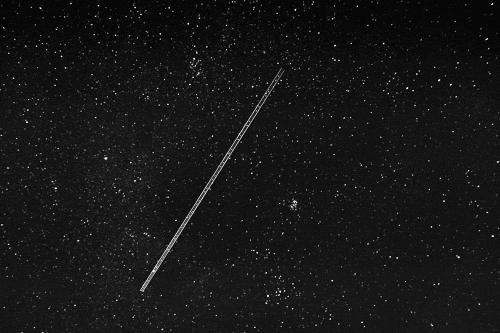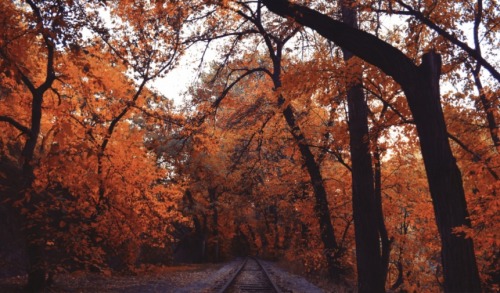🔭🌃🌌
🔭🌃🌌

More Posts from Monstrous-mind and Others
Black Holes Dine on Stellar Treats!

See that tiny blob of light, circled in red? Doesn’t look like much, does it? But that blob represents a feast big enough to feed a black hole around 30 million times the mass of our Sun! Scientists call these kinds of stellar meals tidal disruption events, and they’re some of the most dramatic happenings in the cosmos.

Sometimes, an unlucky star strays too close to a black hole. The black hole’s gravity pulls on the star, causing it to stretch in one direction and squeeze in another. Then the star pulls apart into a stream of gas. This is a tidal disruption event. (If you’re worried about this happening to our Sun – don’t. The nearest black hole we know about is over 1,000 light-years away. And black holes aren’t wild space vacuums. They don’t go zipping around sucking up random stars and planets. So we’re pretty safe from tidal disruption events!)

The trailing part of the stream gets flung out of the system. The rest of the gas loops back around the black hole, forming a disk. The material circling in the disk slowly drifts inward toward the black hole’s event horizon, the point at which nothing – not even light – can escape. The black hole consumes the gas and dust in its disk over many years.

Sometimes the black hole only munches on a passing star – we call this a partial tidal disruption event. The star loses some of its gas, but its own gravity pulls it back into shape before it passes the black hole again. Eventually, the black hole will have nibbled away enough material that the star can’t reform and gets destroyed.

We study tidal disruptions, both the full feasts and the partial snacks, using many kinds of telescopes. Usually, these events are spotted by ground-based telescopes like the Zwicky Transient Facility and the All-Sky Automated Survey for Supernovae network.

They alert other ground- and space-based telescopes – like our Neil Gehrels Swift Observatory (illustrated above) and the European Space Agency’s XMM-Newton – to follow up and collect more data using different wavelengths, from visible light to X-rays. Even our planet-hunting Transiting Exoplanet Survey Satellite has observed a few of these destructive wonders!
We’re also studying disruptions using multimessenger astronomy, where scientists use the information carried by light, particles, and space-time ripples to learn more about cosmic objects and occurrences.

But tidal disruptions are super rare. They only happen once every 10,000 to 100,000 years in a galaxy the size of our own Milky Way. Astronomers have only observed a few dozen events so far. By comparison, supernovae – the explosive deaths of stars – happen every 100 years or so in a galaxy like ours.
That’s why scientists make their own tidal disruptions using supercomputers, like the ones shown in the video here. Supercomputers allow researchers to build realistic models of stars. They can also include all of the physical effects they’d experience whipping ‘round a black hole, even those from Einstein’s theory of general relativity. They can alter features like how close the stars get and how massive the black holes are to see how it affects what happens to the stars. These simulations will help astronomers build better pictures of the events they observe in the night sky.
Keep up with what’s happening in the universe and how we study it by following NASA Universe on Twitter and Facebook.
Make sure to follow us on Tumblr for your regular dose of space!

🔭🌃🌌🍂🍁

Saturn & Tethys - June 2 2007
Credit: NASA/JPL-Caltech/SSI/CICLOPS/Kevin M. Gill
🍁🍂🌄

🍂🍁🍃🎃

🎃Cozy Autumn Blog👻






🔭🌃🌌

Alnitak Region with the Horse Head and Flame Nebulae
by Warren Keller





COSMOS: Possible Worlds 2020
🐈⬛🐈🌌🌆🌕

Pixabay
-
 yorgunmermi liked this · 2 weeks ago
yorgunmermi liked this · 2 weeks ago -
 aydauzayda reblogged this · 2 weeks ago
aydauzayda reblogged this · 2 weeks ago -
 partedwave reblogged this · 2 weeks ago
partedwave reblogged this · 2 weeks ago -
 gokyuzundekedi reblogged this · 2 weeks ago
gokyuzundekedi reblogged this · 2 weeks ago -
 gokyuzundekedi liked this · 2 weeks ago
gokyuzundekedi liked this · 2 weeks ago -
 whiteutopiiaa reblogged this · 2 weeks ago
whiteutopiiaa reblogged this · 2 weeks ago -
 dark-moon-lady liked this · 2 weeks ago
dark-moon-lady liked this · 2 weeks ago -
 5549986 reblogged this · 2 weeks ago
5549986 reblogged this · 2 weeks ago -
 mimi-1412 liked this · 2 weeks ago
mimi-1412 liked this · 2 weeks ago -
 sweetsugarpuff liked this · 2 weeks ago
sweetsugarpuff liked this · 2 weeks ago -
 gamer11guy reblogged this · 2 weeks ago
gamer11guy reblogged this · 2 weeks ago -
 purplequeen20 liked this · 2 weeks ago
purplequeen20 liked this · 2 weeks ago -
 kafaminguzelligi reblogged this · 2 weeks ago
kafaminguzelligi reblogged this · 2 weeks ago -
 marmota-de-alface reblogged this · 2 weeks ago
marmota-de-alface reblogged this · 2 weeks ago -
 ffernweh7 liked this · 2 weeks ago
ffernweh7 liked this · 2 weeks ago -
 ooooxsblog reblogged this · 2 weeks ago
ooooxsblog reblogged this · 2 weeks ago -
 redgraysonofthenight liked this · 2 weeks ago
redgraysonofthenight liked this · 2 weeks ago -
 the-most-handsome-ginger reblogged this · 2 weeks ago
the-most-handsome-ginger reblogged this · 2 weeks ago -
 the-most-handsome-ginger liked this · 2 weeks ago
the-most-handsome-ginger liked this · 2 weeks ago -
 lonelygirldds liked this · 2 weeks ago
lonelygirldds liked this · 2 weeks ago -
 aliencorner liked this · 2 weeks ago
aliencorner liked this · 2 weeks ago -
 silent-sadness liked this · 2 weeks ago
silent-sadness liked this · 2 weeks ago -
 o-druida-ebrio reblogged this · 2 weeks ago
o-druida-ebrio reblogged this · 2 weeks ago -
 thecrowsarecalling reblogged this · 2 weeks ago
thecrowsarecalling reblogged this · 2 weeks ago -
 thehouseof9 reblogged this · 2 weeks ago
thehouseof9 reblogged this · 2 weeks ago -
 thehouseof9 liked this · 2 weeks ago
thehouseof9 liked this · 2 weeks ago -
 iam-thetau reblogged this · 2 weeks ago
iam-thetau reblogged this · 2 weeks ago -
 iam-thetau liked this · 2 weeks ago
iam-thetau liked this · 2 weeks ago -
 ravenswolf reblogged this · 2 weeks ago
ravenswolf reblogged this · 2 weeks ago -
 der-schwartzenmann reblogged this · 2 weeks ago
der-schwartzenmann reblogged this · 2 weeks ago -
 fromtheashes76-2 reblogged this · 2 weeks ago
fromtheashes76-2 reblogged this · 2 weeks ago -
 fuckineedavacation reblogged this · 2 weeks ago
fuckineedavacation reblogged this · 2 weeks ago -
 abssolotto-das liked this · 2 weeks ago
abssolotto-das liked this · 2 weeks ago -
 n-o-t-a-s-de-un-asocial liked this · 2 weeks ago
n-o-t-a-s-de-un-asocial liked this · 2 weeks ago -
 headlesssamurai reblogged this · 2 weeks ago
headlesssamurai reblogged this · 2 weeks ago -
 obabeyi reblogged this · 2 weeks ago
obabeyi reblogged this · 2 weeks ago -
 prttygloomyyy reblogged this · 2 weeks ago
prttygloomyyy reblogged this · 2 weeks ago -
 littlekorok reblogged this · 3 weeks ago
littlekorok reblogged this · 3 weeks ago -
 littlekorok liked this · 3 weeks ago
littlekorok liked this · 3 weeks ago -
 saddy-go-fucky reblogged this · 3 weeks ago
saddy-go-fucky reblogged this · 3 weeks ago -
 autemdi reblogged this · 3 weeks ago
autemdi reblogged this · 3 weeks ago -
 midnight-moon-glow reblogged this · 3 weeks ago
midnight-moon-glow reblogged this · 3 weeks ago -
 ibelivedinmyself liked this · 3 weeks ago
ibelivedinmyself liked this · 3 weeks ago -
 lhnu liked this · 3 weeks ago
lhnu liked this · 3 weeks ago -
 mes-petites-confiseries liked this · 3 weeks ago
mes-petites-confiseries liked this · 3 weeks ago -
 girlwthetattoos liked this · 3 weeks ago
girlwthetattoos liked this · 3 weeks ago -
 punk-faerie reblogged this · 3 weeks ago
punk-faerie reblogged this · 3 weeks ago -
 onewithoutacoolusername reblogged this · 3 weeks ago
onewithoutacoolusername reblogged this · 3 weeks ago -
 onewithoutacoolusername liked this · 3 weeks ago
onewithoutacoolusername liked this · 3 weeks ago -
 ourlandlordwasinthemafia reblogged this · 3 weeks ago
ourlandlordwasinthemafia reblogged this · 3 weeks ago
My ambition is handicapped by laziness. -C. Bukowski Me gustan las personas desesperadas con mentes rotas y destinos rotos. Están llenos de sorpresas y explosiones. -C. Bukowski. I love cats. Born in the early 80's, raised in the 90's. I like Nature, Autumn, books, landscapes, cold days, cloudy Windy days, space, Science, Paleontology, Biology, Astronomy, History, Social Sciences, Drawing, spending the night watching at the stars, Rick & Morty. I'm a lazy ass.
222 posts